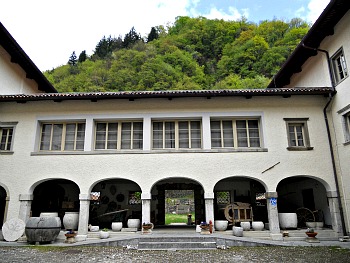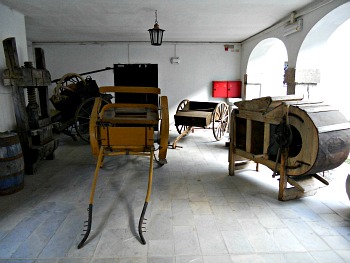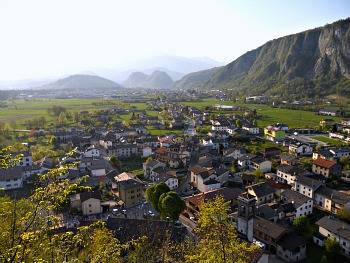- Italy Tours Home
- Italy Ethos
- Tours 2023
- Blog
- Contact Us
- Dolomites
- Top 10 Dolomites
- Veneto
- Dolomites Geology
- Dolomiti Bellunesi
- Cortina
- Cadore
- Belluno
- Cansiglio
- Carso
- Carnia
- Sauris
- Friuli
- Trentino
- Ethnographic Museums
- Monte Baldo
- South Tyrol
- Alta Pusteria
- Dobbiaco
- Emilia-Romagna
- Aosta Valley
- Cinque Terre
- Portofino
- Northern Apennines
- Southern Apennines
- Italian Botanical Gardens
- Padua Botanical Garden
- Orchids of Italy
Tolmezzo: the Small ‘Capital’ of Carnia, Gateway to Many Interesting Sights.

Tolmezzo is a pleasant town, which can rightly be considered the small capital of the mountainous region of Carnia. It has a tiny, compact but atmospheric historical centre, with an arcaded high street and nice shops. There are also some interesting sights.
The Museum of Popular Art of Carnia
The main attraction in Tolmezzo is the Museum of Popular Art of Carnia (“Museo delle Tradizioni e Arti Popolari Carniche”), which is set up in the rooms of 17th century Palazzo Campeis, in the very heart of the historical town. The collections are the result of a patient research work carried out since 1920 by Michele Gortani – a local scholar and eminent politician of his time (1883-1966). The museum, however, only opened in 1963, not long before Gortani’s own death. It holds a rich and interesting collection of ethnographic, artistic and craft objects, laid out over thirty rooms (in the picture above is portrayed the Museum’s central courtyard).
The material displayed illustrates all the main aspects of life, arts and traditions in Carnia from the 14th to the 20th century, and the richness of the objects and findings is such that the Museum of Popular Art in Tolmezzo can be considered one of the finest and most important of its kind in Europe – it certainly is one of the foremost within the Alpine region.
The 30 rooms which constitute the collection are laid out in such a way as to replicate the domestic environments where the objects originally came from – such as kitchens, bedrooms and dining rooms – and the spaces dedicated to work, such as the workshops of the carpenter, the copper beater-brazier, the weaver and the famous cramars (ambulant sellers from the region).
In the basement are the reconstructions of some rooms; here, it is possible to admire two original kitchens: the bigger one has pieces of furniture coming from Casa Fabiani in Paularo, while the second kitchen is more modest, and it displays a cornerstone “foghér” – the typical fireplace of the vernacular Carnian house.
Further on, there are also a living room and three bedrooms with interesting woodcarved furniture – such as elegant etched wardrobes and chests; then a small dining room follows, as well as a section dedicated to the traditional trades: the blacksmiths, joiner & brass-worker and the carpentry workshop – all fully equipped with their original furnishings and tools. In addition, there is a section dedicated to traditional handmade items – such as wrought iron objects, old clocks, textiles, embroideries and common dresses.
Spinning and weaving were very important activities in Carnia since at least the 1500s, but it is only in the late 16th century that these skills reached a peak of mastery – especially thanks to the ability of Jacopo Linussio, who founded in Tolmezzo a small enterprise that was to become a cornerstone in the history of town.
Subsequently acquired by a barrack and therefore not open to the public – although visible on occasions – Palazzo Linussio is not far away from the centre of Tolmezzo itself, and it is one of the most elegant buildings in the region, with beautifully frescoed interiors.
The museum dedicates a lot of space to the processes involved in spinning and weaving, especially in regards to the traditional dresses used both for daily work or worn to celebrate holidays, and with a particular emphasis on feminine costumes – always the richest ones.
Following on from that, the portrait rooms hosting the Ciceri bequest display 200 years of dressing tradition in Carnia. These portraits were often realized by anonymous painters, active mainly during the 18th and 19th century, and even though their original aim was quite different, when seen all together today, the outcome is truly that of a gallery of real characters and caricatures, who baffle us with their surprising intensity of expressions and realism.
They express the customs and traditions of their time, qualifying themselves as iconographic documents in their own right, but important also – from an anthropologic point of view – in order to understand and reconstruct the local history.
Tools linked to cattle farming, and connected with the cycles of life on high-Alpine pastures, also have a dedicated section; in particular, there are objects on display which were used for milk production. Animal bells, carved sticks and pieces of furniture from dairy huts and pens (“malghe” and “casere” in the local language) are also present. Within this part of the museum there are some more monographic rooms containing a range of objects from wrought iron and ceramic items to weights and measures, and to embroidered fabrics.
In the second floor, two rooms are dedicated to works of religious art coming from churches and other buildings such as chapels and monasteries, representing nearly every manufactured article possible: wooden sculptures and altars, crucifixes and Madonna statues of both popular and learned making are shown amongst other objects of daily use for devotion – these coming especially from isolated farmhouses. Most of these objects bear crosses or religious monograms and symbols sculpted, engraved or embroidered on them.
These objects underline how a sense of the sacred permeated every instance of traditional life. In this exhibition, next to the objects tied to domestic worship, wooden sculptures from the 15th and 16th centuries stand out, which originate from churches in the area. They portray the saints most dear to popular devotion, skilfully sculpted, painted and gilded.
Among the curiosities in the museum is a very rich collection of masks, product of different communities across Carnia – so that the diversity of their traditions can be fully appreciated; finally, there is also a valuable collection of old musical instruments.
The part of exhibition outside (in the courtyard, and under the loggia) is dedicated to farming and pastoral life, with a collection of carts and various other tools for agricultural works (see an image below).
All in all, the density of the ethnographic material exhibited in the Museum, which covers a time span from the 13th to the 20th century, allows one to rediscover social-economic events, the history of taste and of the traditions in the area, taking the visitor back to the climate and atmosphere of those times.

Tolmezzo: an Ideal Location in the Heart of Carnia
Tolmezzo lies in a strategic position, which makes it an ideal location for visiting the region of Carnia. There are sights that are quite close, while others are some distance away.
Among the closest destinations is Illegio, a small hamlet just five kilometres away from Tolmezzo town centre. As a village, Illegio is interesting – in and of itself – for its old vernacular architecture, but it is also noteworthy for the exhibitions of religious art which are held there every year in a very picturesque setting.
The main attraction in Illegio, however, is by far the so-called “Mulin dal Ross e dal Flec”, which is a 17th century watermill, still in working conditions. The small building in which it is hosted was originally part of a complex of buildings separated by the two branches of a canal; of these, today, only the mill remains. Before demolition of the industrial compound, the date 1670 was found carved on a capital near the entrance, which probably refers to the founding year of the watermill.
A visit to the mill allows for an educational experience which helps to understand some aspects of life at a time of pre-industrial agriculture. It shows which were the indispensible sources of a domestic economy that was steeped in the rhythms and daily routines of a basically self-sufficient system.
The furniture composing the interior of the mill includes the hopper – which is suspended with a hook on the ceiling – the sieve, the actual millstones and the table where the ground corn-flour can still be observed falling.
The water from the spring, after a small cascade, falls on to the external wheel, which then transmits the movement to the mechanism of another wheel situated in the interior of the mill. A handle regulates the distance between the two wheels, in order to obtain different types of flour – finely or more roughly ground. More detailed information on the mill can be found on the Illegio page.
As anticipated already, though, Tolmezzo is located in a central position in the very heart of Carnia, and it is therefore the ideal base from which to explore the four main valleys that form the region, which are the But valley (or of San Pietro), the valle del Degano or Gorto (these two can be visited with a roundtrip, taking in the minor Val Pesarina too), the Val Chiarsò (or Canale d’Incaroio) – as well as, of course, the main axis formed by the Tagliamento river valley, in the upper reaches of which lie the town of Ampezzo (from where the picturesque mountain village of Sauris can be reached) and the resort of Forni di Sopra.
Along the Tagliamento valley itself, in the section closest to Tolmezzo, there are also some noteworthy buildings and sights to explore, which include the Forra della Vinadia (a natural canyon) and the small but interesting church of the Madonna del Sasso (along the National Road); in the municipality of Villa Santina are the Santuario della Madonna della Trava and the ancient building of the Pieve di Santa Maddalena in Invillino, one of the most acient churches in Carnia. From the latter – which lies isolated on a rocky outcrop – a wide view opens up on the lower section of the valley (see image below), which is verdant and still quite open (the valley becomes narrower as one travels upstream, and more Alpine in outlook).

The Pinacoteca Corbellini
The art of Cornelia Corbellini can be fully considered part of that school of landscape painting falling into the tradition of Veneto and Friuli – to which other names such as those of Marco Davanzo, Pellis and Cussigh can be ascribed – while at the same time differentiating itself from it, for being so sensitive to the language of the French post-Impressionist school.
The influence of this latter tradition can be detected most vividly in her open-air landscapes, where the volumes are described with synthetic, rapid touches that seize – in the varying lights and seasons – delicate atmospheric and tonal passages.
In the language and art of Cornelia Corbellini the colour is the absolute protagonist – a colour that, in its intense and almost physical touches, and in its gestural approach, never forgets the figurative dictates, thus reconstructing the landscape of Carnia with immediacy and freedom.
Even in the still-life the artist reveals a solid preparation for her compositions – for example in her interpretation of the local flora and fruits, which make her art an interesting medium through which to explore and 'read' the land, especially as she often depicts objects that make a direct reference to the artisanal traditions of Carnia.
Even though the focus here is on the connection between her art and the natural world, Cornelia was able to apply the same abilities and executional skills to her portraits, thus revealing a tireless creative vein that captured with expressive autonomy the full-rounded reality of her native land – especially so in more recent works, which are filtered through the eye of memory and a connection of the heart.
Some of the works on display in the Pinacoteca were executed by the artist when she was young in Sappada: here, in the pictorial rendering of the view as a genre, the painter already reveals a sound structure and an early mastering of the techniques employed.
Quintessentially Alpine, the Sappada paintings reveal an exuberance of forms in the depiction of the wooden elements of this atmospheric village, in which the areas of shadow and light are described with freshness and immediacy.
In the still-life genre, which the artist also demonstrates an ability to master, the transparency of matter is rendered through sapient plays of colour-light; in one of the latest works on show, “L’albero azzurro” (‘The Light-Blue Tree’) an explosion of brushstrokes and colour literally takes place, and – with a gestural performance – the branches of a tree full of spring blooms are constructed with exceptional executive freedom. The naturalistic details are absorbed as in a chromatic dance that conjures up a lyrical vision, evoked on the intimate chords of memory and remembrance.
In 2007, the artist left an initial bequest of 30 works to her native town of Tolmezzo, which are now being exposed in Palazzo Frisanco, in the centre of town – a venue also used for other temporary exhibitions, often on the theme of landscape or local traditions and history, and with mediums as diverse as painting, photography and sculpture. In fact, by the express will of Cornelia Corbellini, this Pinacoteca will keep growing in size, hopefully allowing more and more room for other artists creatively connected to – and inspired by – the region of Carnia.
Return from Tolmezzo to Carnia
Return from Tolmezzo to Italy-Tours-in-Nature

New! Comments
Have your say about what you just read! Leave me a comment in the box below.